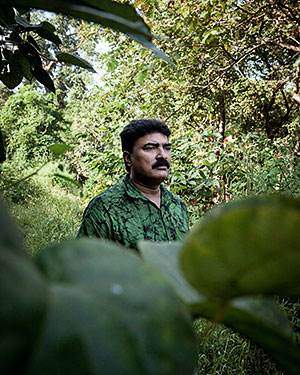First Person: Krishna Tiwari

Simply sign up to the Life & Arts myFT Digest -- delivered directly to your inbox.
Many people don’t realise that even though Mumbai is one of the world’s most densely populated metropolises, the city is carved out of thickly forested jungle. Many Indian leopards live in that same jungle and sometimes they tangle with humans. Between May 2012 and January 2013, leopards killed seven people in the Mumbai suburbs. It was a tragic and frightening time, and it’s my job to educate people on how to cohabit safely with these beautiful cats.
I was 11 when I first saw a leopard. My family lived on the edge of Sanjay Gandhi National Park, and I used to wander into the forests to explore. That’s what I was doing when I came face to face with the leopard. The big cat was lying down in a patch of low grass, and I could tell from his eyes that he was old and sick. Men from a nearby tribal village were laughing and throwing stones, injuring him. The leopard was too weak to defend himself and I was too young and small to speak up. I felt powerless and heartbroken.
It was seeing this that led me, in my teens, to volunteer for conservationist NGOs, defending nature from developers and tending to the safety of animals in the city’s jungles. I would rescue any creature that needed my help – birds, small mammals and even snakes – turning our home into a makeshift veterinary surgery. But the pressure to find a lucrative job became strong, so I studied for a degree in marketing. I worked in that field from 1995 to 2002, and started a family. My life was perfect on the surface, but my memories of the forests stayed with me.
Then, in 2002, the Bombay National Historical Society, a non-profit group devoted to protecting Mumbai’s natural resources, offered me a job running the City Forests programme, conserving those same forested jungles around the area where I grew up. I wrestled with the idea at first – the job paid a fraction of my then salary – but I agreed and have never looked back.
Preventing human/leopard conflict has become my primary role at City Forests. In the past decade the population of the Mumbai suburbs has surged around the edges of Sanjay Gandhi Park and Aarey Milk Colony, which is state-owned land used for dairy production. Shopping malls, luxury apartment complexes and fast-food chains have been built in places that not so long ago were almost completely green.
Suburbanites today leave their garbage outside, so things like chicken bones attract stray dogs. Leopards here evolved to hunt the spotted deer of the forests but as the human populations have moved deeper on to their land, these stray dogs have become their hunting target of choice. Passing cars and auto rickshaws sometimes kill leopards, separating mothers from cubs.
My days are spent riding through the forests on motorbike, educating residents and putting up posters about what they should do if they see a leopard. Many people I speak to have seen one recently and are scared for the safety of their children. One way to avoid an attack is to stay away from tall grassy areas in the forest where leopards like to hunt. The leopards aren’t looking for humans but when people squat to go to the bathroom, or sit down in these areas, they can be mistaken for other animal prey. Sometimes the cats mistake children for prey, and maul them – that’s what happened to a small boy who was killed last month. And I always tell people they should never try to chase the cats away with stones or sticks. The last thing you want to do is make one of these natural hunters mad.
Recently I was called to a village where four leopards were seen stalking. I was surrounded by villagers but I didn’t panic. I reminded them that the cats don’t want to attack humans. In time, the leopards dispersed into the forests. Sometimes my job can be dangerous but this land is my home – and it is my honour to protect it.
Comments